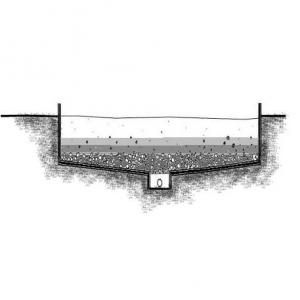المُلخص التنفيذي
An unplanted drying bed is a simple, permeable bed filled with several drainage layers that, when loaded with sludge, collects percolated leachate and allows the sludge to dry by percolation and evaporation. Approximately 50% to 80% of the sludge volume drains off as liquid or evaporates. The sludge, however, is not effectively stabilized or sanitized. Additional treatment by composting may be foreseen for the dried sludge before it can be safely disposed or used as a nutrient-rich soil amendment in agriculture. The percolate still contains pathogens and needs to be collected for treatment or controlled reuse. Unplanted drying beds need to be desludged before fresh sludge is applied. Drying beds are relatively easy to construct and simple to maintain, although large surface areas and man- or mechanical power is required for regular desludging.
| المُدخلات | المُخرَجات |
|---|---|
Compost (for further off-site composting), Soil, Treated Water, Fertigation Water or Water requiering further treatment |
Introduction
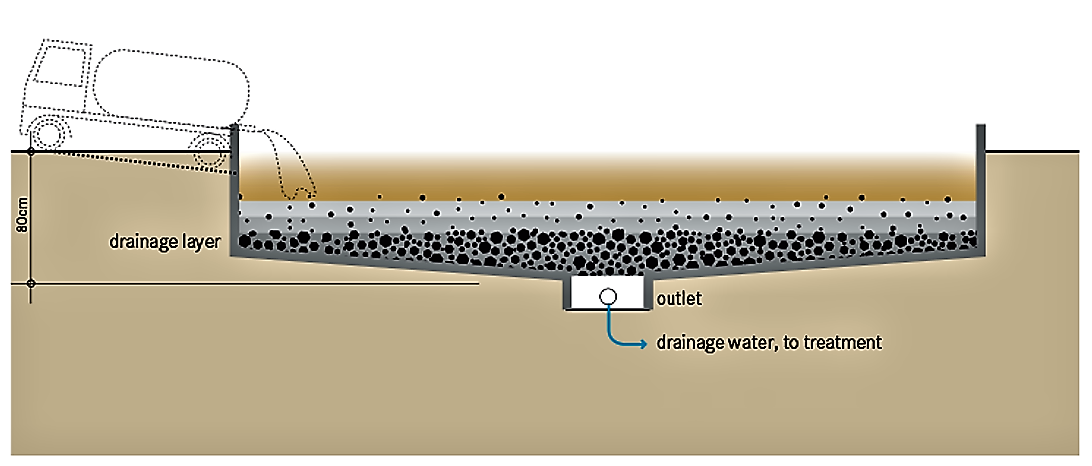
All organic degradation processes produce sludge (SASSE & BORDA 1998). Anaerobic sanitation systems (e.g. single pit latrines, septic tanks, biogas settlers, small and large scale anaerobic digesters, anaerobic digesters for organic waste, wastewater stabilisation pond systems) produce less sludge than aerobic treatments (e.g. from trickling filters, activated sludge) and anaerobic sludge also dries better and results in fewer odours as it is more stabilised. Generally, they do not have a higher solids content than 2 to 10% and can therefore not be transported easily with simple equipment. Apart from this, sludge is contaminated and occupies large volumes for storage (SASSE & BORDA 1998). Therefore it is better to dry or dewater sludge before further use or disposal. Unplanted and Planted Drying beds are one of the simplest and oldest techniques for sludge dewatering (SANIMAS 2005). They are a simple means to reduce the volume of the sludge and prepare reuse as fertiliser.
The bottom of the drying bed is lined with perforated pipes to drain the leachate away that percolates through the bed. On top of the pipes are layers of gravel and sand that support the sludge and allow the liquid to infiltrate and collect in the pipe. While the solid fraction remains on the filter surface and is dried by natural evaporation the liquid percolates. In planted drying beds, the plants enhance evaporation by transpiration. This process is called evapotranspiration. Sludge is applied in layers on top of the gravel beds and is naturally dried. It should not be applied in layers that are too thick (maximum 20 cm), or the sludge will not dry effectively. The final moisture content after 10 to 15 days of drying should be approximately 60%. When the sludge is dried, it must be separated from the sand layer and transported for further treatment, end-use or final disposal. Furthertreatment for instance by composting| allows to stabilise the sludge and the product can be reused as nutrient-rich soil amendment.[/no-ecompendium The leachate that is collected in the drainage pipes must also be treated properly, depending on where it is discharged. Leachate treatment in waste stabilisation ponds prepares the liquid for reuse in irrigation or aquaculture or for surface water disposal. Infiltration through soak pits or leach fields helps to recharge the groundwater.
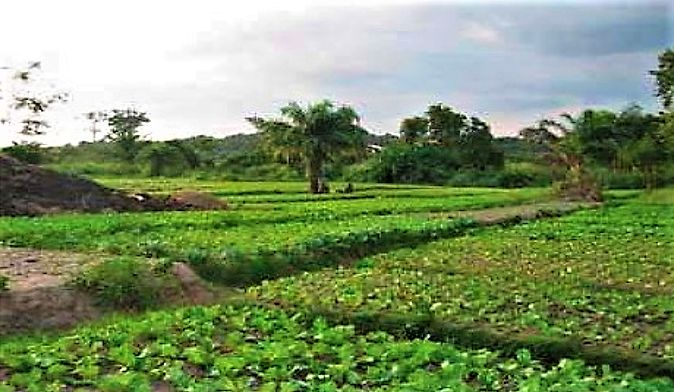
Design Considerations
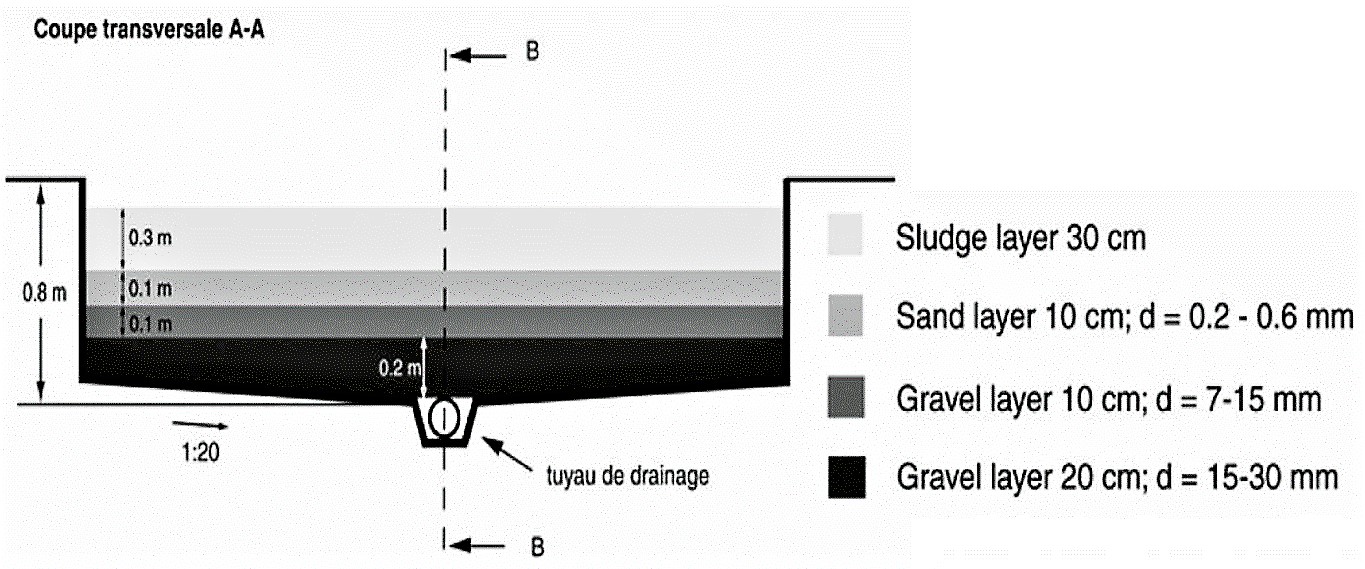
In principle the construction of unplanted drying beds is similar to gravel/sand filters. The bed frame is usually made from concrete or a plastic liner with the bottom surfaces slightly sloped in order to facilitate percolation and drainage. The drainage pipes are covered by 3-5 graded layers of gravel and sand. The bottom layer should be coarse gravel and the top fine sand (0.1 to 0.5 mm effective grain size). The top sand layer should be 250 to 300 mm thick because some sand will be lost each time the sludge is removed (STRAUSS & MONTANGERO 2004; TILLEY et al. 2008). Indication about the diameter of the medium and the height of the different gravel and sand layers vary depending on the source (SASSE & BORDA 1998; STRAUSS & MONTANGERO 2004). Generally, the coarse gravel layer (grain diameter: 15 to 50 mm) is within 20 to 30 cm of height. A gravel layer (diameter of 7 to 15 mm) of 10 to 15 cm follows this layer. This layer can be followed of a similar one of slightly lower diameter (see picture below, STRAUSS & MONTANGERO 2002), but this is not compulsory (SASSE 1998). There should be a final sand layer of 25 to 30 cm.
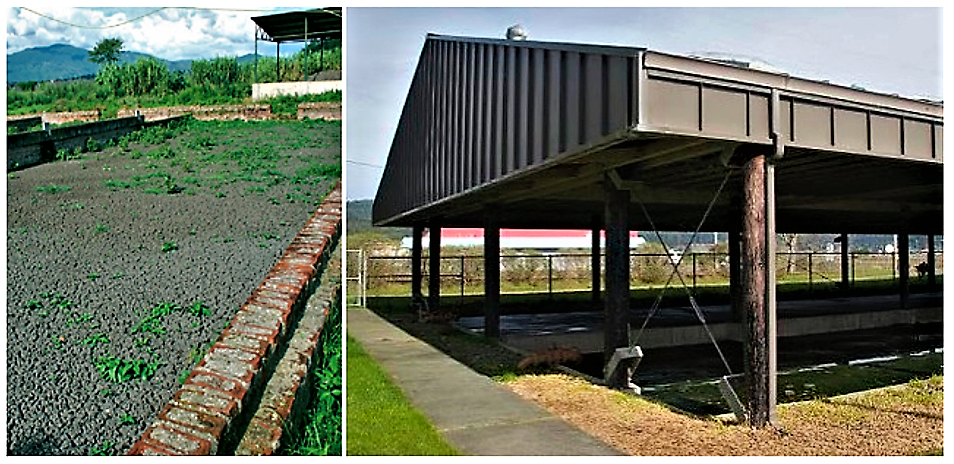
The sludge is applied in a batch mode about once per week intervals in layers of no more than 20 to 30 cm.On an annual basis, about 100 to 200 kg TS/m2 can be applied on a drying bed. Drying takes 10 to 20 days. Land requirements are 0.05 m2 per capita for a 10 days cycle (STRAUSS & MONTANGERO 2002). Before fresh sludge is applied, dried sludge needs to be desludged and brought to a composting site, what makes it a rather laborious treatment option. To improve drying and percolation, sludge application can alternate between two or more beds. About 50 to 80 % of the initial volume is removed by percolation (STRAUSS & MONTANGERO 2002), resulting in total solid (TS) content of 20 to 70 % (STRAUSS & MONTANGERO 2004) depending on the local weather conditions and climate. The inlet should be equipped with a splash plate to prevent erosion of the sand layer and to allow for even distribution of the sludge.
Designing unplanted drying beds has to consider future maintenance because ensuring access to people and trucks for pumping in the sludge and removing the dried sludge is essential.
If installed in wet climates, the facility should be covered by a roof and special caution should be given to prevent the inflow of surface runoff. A fence should prevent animals and people from entering the area.
Health Aspects/Acceptance
Both the incoming and dried sludge are pathogenic; therefore, workers should be equipped with proper protection (boots, gloves, and clothing). Also beds should be installed in a certain distance to settlements, as odour occur, especially when sludge has been recently applied. The dried sludge and effluent are not sanitized and may require further treatment or storage, depending on the desired end-use. Sludge can be composted before reuse to enhance pathogen removal.
The drying bed may cause a nuisance for nearby residents due to bad odours and the presence of flies. Thus, it should be located sufficiently away from residential areas.
Costs Considerations
The investment costs of sludge drying beds are moderate where land prices are low and filter material (gravel/sand) is locally available (SANIMAS 2005). However, the pond may need to be made impermeable and expert skills are required for design. Operation costs are low as no energy or complicated equipment is required. However, desludging is laborious.
Operation and Maintenance
Trained staff for operation and maintenance (application of sludge, desludging, control of drainage system and the control of the secondary treatments for percolate or dried sludge) is required to ensure proper functioning. Even though experts are not compulsory for the operation and maintenance, a well-organised community group, which has experience in organic fertiliser use and preparation should be involved (SANIMAS 2005).
Dried sludge can be removed after 10 to 15 days, but this depends on the climate conditions. Because some sand is lost with every removal of sludge, the top layer must be replaced when it gets thin. The discharge area must be kept clean and the effluent drains should be regularly flushed.
At a Glance
| Working Principle | Drying beds are simple sealed shallow ponds filled with several drainage layers. Sludge is applied on the top and dried by percolation and evaporation. Dried sludge can be used as biosolid in agriculture. |
| Capacity/Adequacy | Requires large land-surfaces and can cause odour; therefore generally installed in rural areas. |
| Performance | Depends strongly on the local climate (rain, runoff); TS content of 20 to 70 % can be achieved. Some of NH4 is lost to air. Pathogen removal is moderate for unplanted beds with short retention time. |
| Costs | Moderate investment costs and low operation costs. |
| Self-help Compatibility | Can be produced with locally available material, but requires expert design. Operation is simple but staff/community should be trained. |
| O&M | Application of sludge, desludging, control of drainage system and of the secondary treatment for percolate or dried sludge. Desludging every one to several weeks. |
| Reliability | High, if the area is kept dry (rain, runoff). |
| Main strength | Low-tech and no requirement of energy. |
| Main weakness | Requires space; odour can occur and frequent desludging. |
Sludge drying beds are a secondary treatment for all kinds of sludge, including faecal sludge from on-site sanitation systems (e.g. septic tanks, semi-centralised systems (e.g. activated sludge), anaerobic digesters (e.g. UASB reactors). Sludge drying is an effective way to decrease the volume of sludge, which is especially important when it has to be transported elsewhere for further treatment, end-use or disposal. The technology is not effective at stabilizing the organic fraction or decreasing the pathogenic content. Further storage or treatment (e.g., Co-Composting) of the dried sludge might be required before use in agriculture. The leachate from dewatering contains also pathogens, mainly bacteria and viruses and has to be further treated as well (STRAUSS et al. 1997) .
Unplanted drying beds are appropriate for small to medium communities with populations up to 100,000 people, but larger ones also exist for huge urban agglomerations. They are best suited for rural and peri-urban areas where there is inexpensive, available space situated far from homes and businesses. If designed to service urban areas, unplanted drying beds should be at the border of the community, but within economic reach for motorized emptying operators.
This is a low-cost option that can be installed in most hot and temperate climates. Excessive rain may prevent the sludge from properly drying. Drying beds are not adapted for regions with heavy rainfalls and frequent flooding or where the water table is high (risk of groundwater pollution). In any case, the ponds should be sealed to prevent infiltration of the pathogen containing percolate and a counter bound can prevent run-off to flow in and animals and people to enter.
Small and Decentralized Wastewater Management Systems
Decentralised wastewater management presents a comprehensive approach to the design of both conventional and innovative systems for the treatment and disposal of wastewater or the reuse of treaded effluent. Smaller treatment plants, which are the concern of most new engineers, are the primary focus of this book.
CRITES, R. TCHOBANOGLOUS, G. (1998): Small and Decentralized Wastewater Management Systems. New York: The McGraw-Hill Companies IncHousehold Water Treatment and Safe Storage (HWTS). Lecture Notes
Lecture notes on the technical and non-technical aspects of sanitation household-level drinking water treatment and safe storage (HWTS) in developing countries.
EAWAG/SANDEC (2008): Household Water Treatment and Safe Storage (HWTS). Lecture Notes. (= Sandec Training Tool 1.0, Module 3 ). Duebendorf: Swiss Federal Institute of Aquatic Science (EAWAG), Department of Water and Sanitation in Developing Countries (SANDEC) URL [Accessed: 08.04.2010]Faecal Sludge Management. Pdf Presentation
A presentation about faecal sludge management in developing countries.
EAWAG ; SANDEC (2008): Faecal Sludge Management. Pdf Presentation. (= Sandec Training Tool 1.0, Module 5 ). Duebendorf: Swiss Federal Institute of Aquatic Science (Eawag), Department of Water and Sanitation in Developing Countries (Sandec) URL [Accessed: 23.05.2012]Urban Compost: A Socio-economic and Agronomic Evaluation in Kumasi, Ghana
Use of Reed Beds for Faecal Sludge Dewatering
This study project tested reed beds for their ability to treat septage.
HEINSS, U. KOOTAATEP, T. (1998): Use of Reed Beds for Faecal Sludge Dewatering. A Synopsis of Reviewed Literature and Interim Results of Pilot Investigations with Septage Treatment in Bangkok, Thailand. Duebendorf and Bangkok: Swiss Federal Institute of Aquatic Science (Eawag), Department of Water and Sanitation in Developing Countries (Sandec) and Asian Institute of Technology (AIT)Solids Separation and Pond Systems for the Treatment of Faecal Sludges in the Tropics
The report sets out to provide guidelines for the preliminary design of faecal sludge treatment schemes comprising solids-liquid separation and stabilisation ponds. The document is based on the results of collaborative field research conducted by the Ghana Water Research Institute and SANDEC on full and pilot-scale faecal sludge (FS) treatment plants located in Accra, Ghana.
HEINSS, U. LARMIE, S.A. STRAUSS, M. (1998): Solids Separation and Pond Systems for the Treatment of Faecal Sludges in the Tropics . Lessons Learnt and Recommendations for Preliminary Design . (= SANDEC Report , 5 ). Duebendorf: Swiss Federal Institute of Aquatic Science (EAWAG), Department of Water and Sanitation in Developing Countries (SANDEC) URL [Accessed: 12.04.2010]Arcata's Wastewater Treatment Plant & The Arcata Marsh and Wildlife Sanctuary
Faecal Sludge Treatment
This document reviews current practices of faecal sludge management and treatment.
MONTANGERO, A. STRAUSS, M. (2004): Faecal Sludge Treatment. Duebendorf: Swiss Federal Institute of Aquatic Science (EAWAG), Department of Water and Sanitation in Developing Countries (SANDEC) URL [Accessed: 10.06.2019]DEWATS
Exhaustive report on technological, operational and economic aspects of decentralised waste water treatment systems. Spreadsheet examples support the reader in designing and planning waste water treatment systems components.
SASSE, L. BORDA (1998): DEWATS. Decentralised Wastewater Treatment in Developing Countries. Bremen: Bremen Overseas Research and Development Association (BORDA) URL [Accessed: 03.06.2019]Faecal Sludge Management
This is the first book to compile the current state of knowledge on faecal sludge management. It addresses the organization of the entire faecal sludge management service chain, from the collection and transport of sludge, to the current state of knowledge of treatment options, and the final end use or disposal of treated sludge. It presents an integrated approach that brings together technology, management, and planning, based on Sandec’s 20 years of experience in the field. It also discusses important factors to consider when evaluating and upscaling new treatment technology options. The book is designed for undergraduate and graduate students, engineers, and practitioners in the field who have some basic knowledge of environmental and/or wastewater engineering.
STRANDE, L. ; RONTELTAP, M. ; BRDJANOVIC, D. (2014): Faecal Sludge Management. Systems Approach for Implementation and Operation. London: IWA Publishing URL [Accessed: 16.07.2014]Treatment of sludges from on-site sanitation — Low-cost options
Published in 1997, this article gives an overview on current literature-based knowledge regarding faecal sludge treatment along with results and conclusions from field research.
STRAUSS, M. ; LARMIE, S.A. ; HEINSS, U. (1997): Treatment of sludges from on-site sanitation — Low-cost options. المُدخلات: Water Science and Technology: Volume 6 , 129-136. URL [Accessed: 23.06.2010]FS Management – Review of Practices, Problems and Initiatives
A study on management and institutional aspects regarding the challenges and possible improvements in managing faecal sludge.
STRAUSS, M. MONTANGERO, A. (2002): FS Management – Review of Practices, Problems and Initiatives. London and Duebendorf: DFID Project R8056, Capacity Building for Effective Decentralised Wastewater Management, Swiss Federal Institute of Aquatic Science (EAWAG), Department of Water and Sanitation in Developing Countries (SANDEC) URL [Accessed: 28.05.2019]Wastewater Engineering, Treatment and Reuse
Compendium of Sanitation Systems and Technologies. 2nd Revised Edition
This compendium gives a systematic overview on different sanitation systems and technologies and describes a wide range of available low-cost sanitation technologies.
TILLEY, E., ULRICH L., LÜTHI, C., REYMOND P. and ZURBRÜGG C. (2014): Compendium of Sanitation Systems and Technologies. 2nd Revised Edition. Duebendorf, Switzerland: Swiss Federal Institute of Aquatic Science and Technology (Eawag) URL [Accessed: 03.05.2023] PDFCompendium of Sanitation Systems and Technologies
This compendium gives a systematic overview on different sanitation systems and technologies and describes a wide range of available low-cost sanitation technologies.
TILLEY, E., LUETHI, C., MOREL, A., ZURBRUEGG, C. and SCHERTENLEIB, R. (2008): Compendium of Sanitation Systems and Technologies. Duebendorf, Switzerland: Swiss Federal Institute of Aquatic Science and Technology (EAWAG) and Water Supply and Sanitation Collaborative Council (WSSCC) URL [Accessed: 15.02.2010] PDFCompendium of Sanitation Systems and Technologies (Arabic)
This is the Arabic version of the Compendium of Sanitation Systems and Technologies. The Compendium gives a systematic overview on different sanitation systems and technologies and describes a wide range of available low-cost sanitation technologies.
TILLEY, E. ULRICH, L. LUETHI, C. REYMOND, P. SCHERTENLEIB, R. ZURBRUEGG, C. (2014): Compendium of Sanitation Systems and Technologies (Arabic). 2nd Revised Edition. Duebendorf, Switzerland: Swiss Federal Institute of Aquatic Science and Technology (Eawag) PDFSludge Treatment and Disposal
Sludge Treatment and Disposal is the sixth volume in the series Biological Wastewater Treatment. The book covers in a clear and informative way the sludge characteristics, production, treatment (thickening, dewatering, stabilisation, pathogens removal) and disposal (land application for agricultural purposes, sanitary landfills, landfarming and other methods). Environmental and public health issues are also fully described.
ANDREOLI, C.V. ; SPERLING, M. von ; FERNANDES, F. (2007): Sludge Treatment and Disposal. (= Biological Wastewater Treatment Series , 6 ). London: International Water Association (IWA) Publishing URL [Accessed: 27.05.2019]Small and Decentralized Wastewater Management Systems
Decentralised wastewater management presents a comprehensive approach to the design of both conventional and innovative systems for the treatment and disposal of wastewater or the reuse of treaded effluent. Smaller treatment plants, which are the concern of most new engineers, are the primary focus of this book.
CRITES, R. TCHOBANOGLOUS, G. (1998): Small and Decentralized Wastewater Management Systems. New York: The McGraw-Hill Companies IncFaecal Sludge Treatment
This document reviews current practices of faecal sludge management and treatment.
MONTANGERO, A. STRAUSS, M. (2004): Faecal Sludge Treatment. Duebendorf: Swiss Federal Institute of Aquatic Science (EAWAG), Department of Water and Sanitation in Developing Countries (SANDEC) URL [Accessed: 10.06.2019]Full-Chain Sanitation Services That Last
This paper sets out a framework for the delivery of non-sewered sanitation services that last, are accessible to all and are at scale. The framework is based on IRC International Water and Sanitation’s (IRC) experience and lessons learnt from its engagement in non-sewered sanitation service at scale.
VERHAGEN, J. CARRASCO, M. (2013): Full-Chain Sanitation Services That Last. Non-Sewered Sanitation Services. The Hague: International Water and Sanitation Center (IRC) URL [Accessed: 03.06.2019]Solids Separation and Pond Systems for the Treatment of Faecal Sludges in the Tropics
The report sets out to provide guidelines for the preliminary design of faecal sludge treatment schemes comprising solids-liquid separation and stabilisation ponds. The document is based on the results of collaborative field research conducted by the Ghana Water Research Institute and SANDEC on full and pilot-scale faecal sludge (FS) treatment plants located in Accra, Ghana.
HEINSS, U. LARMIE, S.A. STRAUSS, M. (1998): Solids Separation and Pond Systems for the Treatment of Faecal Sludges in the Tropics . Lessons Learnt and Recommendations for Preliminary Design . (= SANDEC Report , 5 ). Duebendorf: Swiss Federal Institute of Aquatic Science (EAWAG), Department of Water and Sanitation in Developing Countries (SANDEC) URL [Accessed: 12.04.2010]Use of Reed Beds for Faecal Sludge Dewatering
This study project tested reed beds for their ability to treat septage.
HEINSS, U. KOOTAATEP, T. (1998): Use of Reed Beds for Faecal Sludge Dewatering. A Synopsis of Reviewed Literature and Interim Results of Pilot Investigations with Septage Treatment in Bangkok, Thailand. Duebendorf and Bangkok: Swiss Federal Institute of Aquatic Science (Eawag), Department of Water and Sanitation in Developing Countries (Sandec) and Asian Institute of Technology (AIT)SOS - Management of Sludges from On-Site Sanitation. Characteristics of Faecal Sludges and their Solids-Liquid Separation
This document gives an overview on the characteristics of different sludges as well as monitoring results and recommendations for design of solid-liquid separation. It is based on a field report.
HEINSS, U. LARMIE, S.A. STRAUSS, M. (1999): SOS - Management of Sludges from On-Site Sanitation. Characteristics of Faecal Sludges and their Solids-Liquid Separation. Duebendorf and Accra: Swiss Federal Institute of Aquatic Science (EAWAG)SOS - Management of Sludges from On-Site Sanitation. Co-treatment of Faecal Sludge and Wastewater in Tropical Climates
This article provides operational and design guidance for the co-treatment of faecal sludge in waste stabilisation ponds and in activated sludge sewage treatment plants. Problems which may arise when highly concentrated faecal sludge is not properly included in the design of the co-treatment system are also discussed.
HEINSS, U. STRAUSS, M. (1999): SOS - Management of Sludges from On-Site Sanitation. Co-treatment of Faecal Sludge and Wastewater in Tropical Climates. Duebendorf and Accra: Swiss Federal Institute of Aquatic Science (EAWAG) URL [Accessed: 21.04.2010]Fecal Sludge Management in Developing Countries - A Planning Manual
This manual is a first approach to provide guidance on strategic planning of faecal sludge management. The study took place in the City of Nam Dinh, in Vietnam. The main principles for strategic sanitation planning have been adopted from the guide “Strategic Planning for Municipal Planning” from GHK Research and Training Ltd.
KLINGEL, F. MONTANGERO, A. KONE, M. STRAUSS, M. (2002): Fecal Sludge Management in Developing Countries - A Planning Manual. (= First Edition ). Duebendorf: Swiss Federal Institute for Environmental Science (EAWAG) URL [Accessed: 08.06.2019]Faecal Sludge Treatment
This document reviews current practices of faecal sludge management and treatment.
MONTANGERO, A. STRAUSS, M. (2004): Faecal Sludge Treatment. Duebendorf: Swiss Federal Institute of Aquatic Science (EAWAG), Department of Water and Sanitation in Developing Countries (SANDEC) URL [Accessed: 10.06.2019]How to Select Appropriate Technical Solutions for Sanitation
The purpose of this guide is to assist local contracting authorities and their partners in identifying those sanitation technologies best suited to the different contexts that exist within their town. The first part of the guide contains a planning process and a set of criteria to be completed; these assist you in characterizing each area of intervention so that you are then in a position to identify the most appropriate technical solutions. The second part of the guide consists of technical factsheets which give a practical overview of the technical and economic characteristics, the operating principle and the pros and cons of the 29 sanitation technology options most commonly used in sub-Saharan Africa.
MONVOIS, J. GABERT, J. FRENOUX, C. GUILLAUME, M. (2010): How to Select Appropriate Technical Solutions for Sanitation. (= Six Methodological Guides for a Water and Sanitation Services' Development Strategy , 4 ). Cotonou and Paris: Partenariat pour le Développement Municipal (PDM) and Programme Solidarité Eau (pS-Eau) URL [Accessed: 19.10.2011]Faecal Sludge Management
This is the first book to compile the current state of knowledge on faecal sludge management. It addresses the organization of the entire faecal sludge management service chain, from the collection and transport of sludge, to the current state of knowledge of treatment options, and the final end use or disposal of treated sludge. It presents an integrated approach that brings together technology, management, and planning, based on Sandec’s 20 years of experience in the field. It also discusses important factors to consider when evaluating and upscaling new treatment technology options. The book is designed for undergraduate and graduate students, engineers, and practitioners in the field who have some basic knowledge of environmental and/or wastewater engineering.
STRANDE, L. ; RONTELTAP, M. ; BRDJANOVIC, D. (2014): Faecal Sludge Management. Systems Approach for Implementation and Operation. London: IWA Publishing URL [Accessed: 16.07.2014]Co-composting of Faecal Sludge and Municipal Organic Waste
The document gives an overview on the combined composting of (faecal) sludges and organic solid waste based on a pilot project in Kumasi, Ghana. Results of the investigation should help the city’s waste management department to develop its biosolids management strategy and enable the project team to develop guidelines for planners and engineers on the option of co-composting.
STRAUSS, M. DRESCHER, S. ZURBRUEGG, C. MONTANGERO, A. OLUFUNKE, C. DRECHSEL, P. (2003): Co-composting of Faecal Sludge and Municipal Organic Waste. Swiss Federal Institute of Aquatic Science (EAWAG), Department of Water and Sanitation in Developing Countries (SANDEC) and International Water Management Institute (IWMI) URL [Accessed: 05.06.2019]Treatment of sludges from on-site sanitation — Low-cost options
Published in 1997, this article gives an overview on current literature-based knowledge regarding faecal sludge treatment along with results and conclusions from field research.
STRAUSS, M. ; LARMIE, S.A. ; HEINSS, U. (1997): Treatment of sludges from on-site sanitation — Low-cost options. المُدخلات: Water Science and Technology: Volume 6 , 129-136. URL [Accessed: 23.06.2010]Compendium of Sanitation Systems and Technologies. 2nd Revised Edition
This compendium gives a systematic overview on different sanitation systems and technologies and describes a wide range of available low-cost sanitation technologies.
TILLEY, E., ULRICH L., LÜTHI, C., REYMOND P. and ZURBRÜGG C. (2014): Compendium of Sanitation Systems and Technologies. 2nd Revised Edition. Duebendorf, Switzerland: Swiss Federal Institute of Aquatic Science and Technology (Eawag) URL [Accessed: 03.05.2023] PDFWhat Happens When the Pit is Full?
This seminar report helps people responsible for the sustainable operation of on-site sanitation systems. It shows new developments in the field and contains a lot of detailed information about Faecal Sludge Management (FSM).
WINSA (2011): What Happens When the Pit is Full?. Developments in On-Site Faecal Sludge Management (FSM). Durban: Water Information Network South Afrika (WINSA) URL [Accessed: 06.10.2011]Technology Transfer – Forage Plants Used in Faecal Sludge Dewatering Beds in Sub-Saharan Africa
In collaboration with the Asian Institute of Technology (AIT), Bangkok, Eawag has previously demonstrated that constructed wetlands, especially in Thailand, offer a viable solution for the treatment of faecal sludge. However, since the characteristics of sludge vary widely from one region to another, appropriate indigenous plants had to be identified so as to ensure successful operation of these facilities.
KONE, D. ; KENGE, I. (2008): Technology Transfer – Forage Plants Used in Faecal Sludge Dewatering Beds in Sub-Saharan Africa. المُدخلات: Sandec News: Volume 9Low-cost Options for Treating Faecal Sludges (FS) in Developing Countries - Challenges and Performance
This article analyses and discusses the performances of low-cost technology for treating faecal sludges in developing countries. It shows that where septic tanks are the predominant type of on-site sanitation installations, septage is the only or predominant type of faecal sludge generated. It also shows that constructed wetlands, settling tanks/ponds, or unplanted drying beds might prove suitable as a pre-treatment.
KONE, D. STRAUSS, M. (2004): Low-cost Options for Treating Faecal Sludges (FS) in Developing Countries - Challenges and Performance. Duebendorf: Water and Sanitation in Developing Countries (SANDEC), Swiss Federal Institute for Environmental Science (EAWAG) URL [Accessed: 23.06.2010]Improvement of Sanitation at Kanawat Health Center Uganda
This study reports the improvement of the sanitation systems of a rural public health centre in Kanawat, Uganda. Excreta from UDDTs and composting pit latrines are treated together in sludge drying beds. Greywater is treated in a sludge drying bed and a constructed wetland and finally reused for irrigation.
MUELLEGGER, E. SCHLICK, J. WERNER, C. (2009): Improvement of Sanitation at Kanawat Health Center Uganda. (= SuSanA - Case Studies ). Eschborn: Sustainable Sanitation Alliance (SuSanA) URL [Accessed: 22.05.2012]Co-composting faecal sludge & organic solid waste, Kumasi, Ghana
This project aimed to gain scientific knowledge on the technical, socio-economical and operational aspects of co-composting (organic solid waste and faecal material). Dried faecal sludge (drying bed) is co-composted with the organic fraction of solid waste. The final product is used as compost for urban and periurban agriculture.
OLUFUNKE, C. DOULAYE, K. (2009): Co-composting faecal sludge & organic solid waste, Kumasi, Ghana. (= SuSanA - Case Studies ). Eschborn: Sustainable Sanitation Alliance (SuSanA) URL [Accessed: 22.05.2012]Chapter 3. Pilot Project "Navsarjan Vocational Training Institute Dalit Shakti Kendra"
The main aim of the project was to avoid manual scavenging of excreta and to improve the sanitation situation at the Navsarjan Vocational Training Institute. The technical solution proposed was source separation (grey-/blackwater) and reuse. Greywater is separately treated and reused in the garden while the urine and faeces (blackwater) are directly introduced into a biogas plant. Digested sludge is dried on basic drying beds and used as compost for the garden. UDDT were also installed. The concept was implemented and evaluated for its social and cultural acceptability, sustainable and hygienic safety.
WAFLER, M. (2006): Chapter 3. Pilot Project "Navsarjan Vocational Training Institute Dalit Shakti Kendra". المُدخلات: WAFLER, M. ; HEEB, J. ; (2006): Report on Case Studies of ecosan Pilot Projects in India. Eschborn: . URL [Accessed: 26.04.2010]Decentralized Wastewater Mgmt at Adarsh College, Badalapur, Maharashtra, India
This case study reports the development of an ecologically sound sanitation concept at Adarsh Bidyaprasarak Sanstha's College of Arts & Commerce. It comprises separate urine collection and a DEWATS system for the treatment of black- and greywater consisting of biogas settler, an anaerobic baffled reactor, and anaerobic filter, a horizontal flow wetland and a polishing pond.
ZIMMERMANN, N. WAFLER, M. (2009): Decentralized Wastewater Mgmt at Adarsh College, Badalapur, Maharashtra, India. (= SuSanA - Case Studies ). Eschborn: Sustainable Sanitation Alliance (SuSanA) URL [Accessed: 22.05.2012]Faecal Sludge Management. Lecture Notes
This module pays special attention to the haulage, treatment and reuse or disposal of faecal sludge. It covers both technical and non-technical (socio-cultural, economic, political etc.) aspects and provides practical information on design, financing and planning of faecal sludge treatment plants.
EAWAG/SANDEC (2008): Faecal Sludge Management. Lecture Notes. (= Sandec Training Tool 1.0, Module 5 ). Duebendorf: Swiss Federal Institute of Aquatic Science (EAWAG), Department of Water and Sanitation in Developing Countries (SANDEC) URL [Accessed: 23.05.2012]Faecal Sludge Management. Pdf Presentation
A presentation about faecal sludge management in developing countries.
EAWAG ; SANDEC (2008): Faecal Sludge Management. Pdf Presentation. (= Sandec Training Tool 1.0, Module 5 ). Duebendorf: Swiss Federal Institute of Aquatic Science (Eawag), Department of Water and Sanitation in Developing Countries (Sandec) URL [Accessed: 23.05.2012]Faecal Sludge Treatment
This document reviews current practices of faecal sludge management and treatment.
MONTANGERO, A. STRAUSS, M. (2004): Faecal Sludge Treatment. Duebendorf: Swiss Federal Institute of Aquatic Science (EAWAG), Department of Water and Sanitation in Developing Countries (SANDEC) URL [Accessed: 10.06.2019]DEWATS
Exhaustive report on technological, operational and economic aspects of decentralised waste water treatment systems. Spreadsheet examples support the reader in designing and planning waste water treatment systems components.
SASSE, L. BORDA (1998): DEWATS. Decentralised Wastewater Treatment in Developing Countries. Bremen: Bremen Overseas Research and Development Association (BORDA) URL [Accessed: 03.06.2019]FS Management – Review of Practices, Problems and Initiatives
A study on management and institutional aspects regarding the challenges and possible improvements in managing faecal sludge.
STRAUSS, M. MONTANGERO, A. (2002): FS Management – Review of Practices, Problems and Initiatives. London and Duebendorf: DFID Project R8056, Capacity Building for Effective Decentralised Wastewater Management, Swiss Federal Institute of Aquatic Science (EAWAG), Department of Water and Sanitation in Developing Countries (SANDEC) URL [Accessed: 28.05.2019]Informed Choice Catalogue
This informed choice catalogue for community based wastewater treatment technologies helps to identify suitable sanitation options and facilitates the assessment of different sanitation system components with regard to stakeholder preferences. A powerful tool for technical bottom-up planning giving overall information about technical options at a "glance".
SANIMAS (2005): Informed Choice Catalogue. pdf presentation. BORDA and USAID URL [Accessed: 29.05.2019]Environmentally sound technologies in wastewater treatment for the implementation of the UNEP/GPA "Guidelines on Municipal Wastewater Management"
Technical information on environmentally sound technologies in wastewater treatment.
UNEP ; MURDOCH UNIVERSITY (2004): Environmentally sound technologies in wastewater treatment for the implementation of the UNEP/GPA "Guidelines on Municipal Wastewater Management". The Hague: United Nations Environment Programme Global Programme of Action (UNEP/GPA), Coordination OfficeUrban Excreta Management - Situation, Challenges, and Promising Solutions
The objective of this paper is to render planners, decision makers, and consultants aware that faecal sludge management (FSM) should form an integral part of the urban development planning process. For this, three illustrative cases are presented, based on which an array of measures or tools, as well as institutional/regulatory, financial/economic, and technical aspects are discussed.
STRAUSS, M. ; BARREIRO, W.C. ; STEINER, M. ; MENSAH, A. ; JEULAND, M. ; BOLOMEY, S. ; MONTANGERO, A. ; KONE, D. (2003): Urban Excreta Management - Situation, Challenges, and Promising Solutions. المُدخلات: IWA Asia-Pacific Regional Conference Bangkok, Thailand: URL [Accessed: 23.06.2010]http://www.eawag.ch/
The department of Water and Sanitation in Developing Countries (SANDEC) at the Swiss Federal Institute of Aquatic Science (EAWAG) is a centre of excellence in the domain of faecal sludge treatment and management and many helpful publications can be downloaded.
http://www.unep.or.jp/
Link to the online version of the “International Source Book On Environmentally Sound Technologies for Wastewater and Stormwater Management” from the United Nations Environmental Programme. This section is about drying beds.

